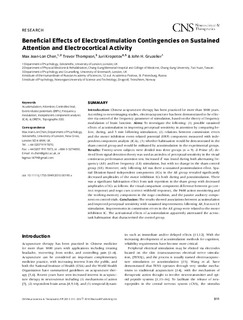| dc.contributor.author | Chen, Max Jean-Lon | |
| dc.contributor.author | Thompson, Trevor | |
| dc.contributor.author | Kropotov, Yury | |
| dc.contributor.author | Gruzelier, John H | |
| dc.date.accessioned | 2019-10-10T09:29:26Z | |
| dc.date.available | 2019-10-10T09:29:26Z | |
| dc.date.created | 2011-10-24T09:53:34Z | |
| dc.date.issued | 2011 | |
| dc.identifier.citation | CNS Neuroscience & Therapeutics. 2011, 17 (5), 311-326. | nb_NO |
| dc.identifier.issn | 1755-5930 | |
| dc.identifier.uri | http://hdl.handle.net/11250/2621348 | |
| dc.description.abstract | Introduction: Chinese acupuncture therapy has been practiced for more than 3000 years. According to neuroimaging studies, electroacupuncture has been demonstrated to be effective via control of the frequency parameter of stimulation, based on the theory of frequency modulation of brain function. Aims: To investigate the following: (1) possible sustained effects of acustimulation in improving perceptual sensitivity in attention by comparing before, during, and 5 min following stimulation; (2) relations between commission errors and the motor inhibition event‐related potential (ERP) component measured with independent component analysis (ICA); (3) whether habituation would be demonstrated in the sham control group and would be militated by acustimulation in the experimental groups. Results: Twenty‐seven subjects were divided into three groups (n = 9). d‐Prime (d′) derived from signal detection theory was used as an index of perceptual sensitivity in the visual continuous performance attention test. Increased d′ was found during both alternating frequency (AE) and low frequency (LE) stimulation, but with no change in the sham control group (SE). However, only following AE was there a sustained poststimulation effect. Spatial filtration‐based independent components (ICs) in the AE group revealed significantly decreased amplitudes of the motor inhibition ICs both during and poststimulation. There was a significant habituation effect from task repetition in the sham group with decreased amplitudes of ICs as follows: the visual comparison component difference between go (correct response) and nogo cues (correct withheld response), the P400 action monitoring and the working memory component in the nogo condition, and the passive auditory component on control trials. Conclusion: The results showed associations between acustimulation and improved perceptual sensitivity with sustained improvements following AE, but not LE stimulation. Improvements in commission errors in the AE group were related to the motor inhibition IC. The activational effects of acustimulation apparently attenuated the across‐task habituation that characterized the control group. | nb_NO |
| dc.language.iso | eng | nb_NO |
| dc.publisher | Wiley | nb_NO |
| dc.rights | Navngivelse-Ikkekommersiell 4.0 Internasjonal | * |
| dc.rights.uri | http://creativecommons.org/licenses/by-nc/4.0/deed.no | * |
| dc.title | Beneficial Effects of Electrostimulation Contingencies on Sustained Attention and Electrocortical Activity | nb_NO |
| dc.type | Journal article | nb_NO |
| dc.type | Peer reviewed | nb_NO |
| dc.description.version | publishedVersion | nb_NO |
| dc.source.pagenumber | 311-326 | nb_NO |
| dc.source.volume | 17 | nb_NO |
| dc.source.journal | CNS Neuroscience & Therapeutics | nb_NO |
| dc.source.issue | 5 | nb_NO |
| dc.identifier.doi | 10.1111/j.1755-5949.2010.00190.x | |
| dc.identifier.cristin | 847316 | |
| dc.description.localcode | Open Access CC-BY-NC | nb_NO |
| cristin.unitcode | 194,67,40,0 | |
| cristin.unitname | Institutt for psykologi | |
| cristin.ispublished | true | |
| cristin.fulltext | original | |
| cristin.qualitycode | 1 | |

